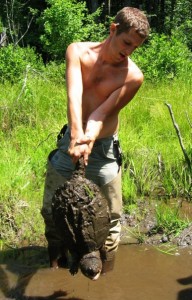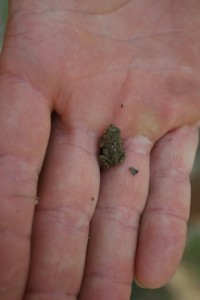Graham Laing is my brother, and I don’t think he’d be offended by my telling you that some of us in the family were a little worried that he might not amount to anything. But that’s another story for another day. Today, he’s a fish hatchery technician, which basically means he raises trout — “from eggs to eating size,” he says. That means he moves truckloads of live fish from pond to pond (and raceway and stream) according to their size, and he treats them for parasites and other oogie things. He also does a lot of weed whacking and mushroom hunting.
You might not think that a guy who works outside all day long would use math, but Graham does. And I think his approach is pretty unique. As you read through this, see if you can figure out what he’s not doing. I’ll share my thoughts at the end.

When do you use basic math in your job?
I use basic math every day. When we load the trucks in the morning, we’re told to load a certain amount of pounds of fish per tank on the truck. Since we can’t load all of the fish at one time, we’re handed a net of fish that usually weighs between 40 and 50 pounds. We have to keep track, in our heads, of how many pounds we have in each tank until it is loaded.
I also use basic math when we treat fish for parasites, using either salt or formalin. Salt baths depend on volume, so I find the volume of the tank in cubic feet and then multiply that by the number of gallons in a cubic foot–to get the total number of gallons to be treated. Then I have to multiply that by the number of pounds in a gallon of water to find the total number of pounds of water to be treated. Since we usually do a 5% salt bath, we find the number of pounds in 5% of the volume and weigh the salt. Finally, we can mix the salt in the water.
When treating with formalin, we have to calculate a gallons-per-minute flow rate. We find this by counting the number of seconds it takes to fill a gallon and then divide that number into 60. (There are 60 seconds in a minute.) So if it takes 10 seconds to fill a gallon, the flow rate is 6 gallons per minute. Since the treatment runs for an hour, I multiply by 60 and then multiply that number by 0.0036, which is the number of grams of formalin needed per gallon. Finally, I multiply by the parts-per-million needed for the treatment, which depends on the water temperature.
Do you use any technology to help with this math?
I use calculators for sampling and for calculating the treatments. If we’re doing a lot of samples at one time, we plug the numbers into an excel spreadsheet that has the formulas we need. Calculators reduce error. One blown sample due to error could cause us to underestimate the number of fish in a raceway. Or it could cause us to underfeed a raceway, resulting in a large size-variation of the fish.
How do you think math helps you do your job better?

My whole job revolves around math. Without math, the fish would die or become infected with parisites. We would not know how many fish we have on the farm, and we wouldn’t know if we were reaching our stocking goal set forth by the state.
How comfortable with math do you feel? Does this math feel different to you?
I feel very comfortable with math and have since I was a very small child. When I got this job, I had all the skills I needed — it just took a little remembering to become adept at using them.
What kind of math did you take in high school? Did you like it or feel like you were good at it?
I took algebra, geometry, and trig. I was forced to take trig, so I didn’t do so well in it. I slept through trig everyday and was still able to make 40s and 50s on the tests just by intuition.
Trust me. If you met Graham you wouldn’t know he’s a math geek. He doesn’t give a whit about calculus or abstract algebra or fractals. He’s just really good at mental math.
Here’s the interesting thing about Graham’s process: All of the math he describes above can be represented by formulas. And when Graham uses a spreadsheet for the math, he has to use the formulas. BUT when he uses math in the field, he unpacks each formula into a set of steps. (First multiply, then divide, then multiply, etc.) He doesn’t have to memorize a formula to do the work. Instead, he thinks about the process, and he’s attached meaning to each step (“divide by 60 because there are 60 seconds in a minute”), so he doesn’t forget to do something. This is the foundation of mental math — breaking up complicated problems into doable steps.
I’m betting many of you do the same thing. Want to share that process in the comment section? I sure hope you will!
And if you have questions for Graham — whether they’re about huge snapping turtles, tiny toads or wildlife management in general — post them, and I’ll be sure to get Graham to answer them. (I am his big sister, so I can boss him around — a little bit.)